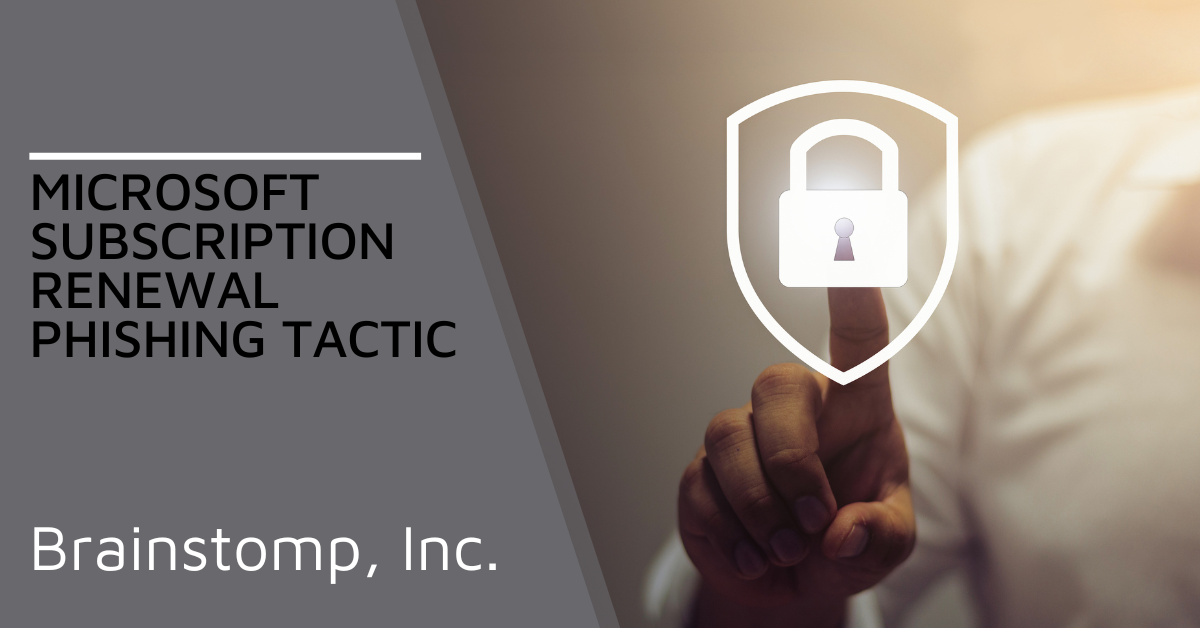Microsoft Subscription Renewal Phishing Tactic
/Have you ever opened an email and felt that something’s just off, but you couldn’t quite put your finger on it?
That one second of hesitation might be the only thing standing between your company and a full-on breach.
A new phishing scam targeting Microsoft 365 users is making the rounds—and it’s slick. It mimics a real subscription renewal notice, uses fake calendar invites to create urgency, and leads to a convincing but completely fake Microsoft billing portal. One click, and your firm’s data, financial info, and login credentials could all be gone.
According to The Fintech Times, 94% of organizations experienced a successful cybercrime in the past year.
This isn’t a story about “those companies over there.” It is currently happening, and it only takes one person to make the mistake of falling for it.
Let's understand how this scam takes place, its negative effects, and how strong IT solutions can solve these issues and keep your teams and data safe.
Scams Are Smarter, And Your Protection Needs to Be Too
Email scams are getting smarter—less obvious, more convincing. It’s no longer just bad grammar. It’s well-timed, polished, and dangerously believable.
And look—we get it. Most people don’t have time to inspect every email, every link, and every attachment. That’s where a good IT strategy steps in.
We have to accept the fact that not every team member can tackle cybersecurity issues like an expert. But what you can provide them with is access to tools and support to stay safe.
How the Scam Works: Step by Step
Step 1: The Email Looks Legit (At First)
It starts with an email that appears to come from “Microsoft Billing.” It claims your Microsoft 365 subscription couldn’t be renewed and asks you to take immediate action.
The email also attaches an .ics calendar file—which automatically adds a “blocked” time slot to your Outlook calendar. Now you’ve got a meeting reminder staring you in the face, pressuring you to act quickly.
This trick isn’t just clever—it’s manipulative. It creates psychological urgency that makes people skip the usual gut checks.
Step 2: The Attachment Sets the Trap
Attached to the email is a local HTML file, named to look like a secure billing statement. When opened, it launches a fake Microsoft billing portal that’s nearly identical to the real thing.
Users are prompted to enter their credit card details, contact info, and login credentials for a “$5.29 monthly renewal.”
The page shows “processing” animations and warning messages to make the experience feel real.
But it’s all fake.
Step 3: The Damage is Done
Once submitted, your data is in the hands of scammers. The email wasn’t sent from Microsoft at all—it came from a compromised .shop domain.
What do the attackers gain?
Credit card numbers
Business and personal data
Corporate email credentials
And what do you lose? Potentially—everything.
Why This Phishing Scam Is So Dangerous
This isn’t your average “Nigerian prince” email. This campaign is:
Well-designed and professional-looking
Loaded with urgency triggers (calendar invites, alerts, etc.)
Hosted locally, making it hard for email filters to detect
Leveraging trust in Microsoft’s brand
It’s not just about stealing one credit card. If hackers steal email credentials, they can access systems, spread malware, and leak client data, damaging your business and reputation fast.
One Click Can Cost You Everything
It only takes one team member clicking one attachment to bring your business to a halt.
Think about it:
Do you have a plan if your Outlook inbox gets hijacked?
How long would it take to recover if attackers accessed your client list or internal files?
How do you explain to clients that their information might be compromised?
Cyberattacks aren’t just an IT problem—they’re a business problem. And if you wait until after something happens to act, you’re already behind.
How to Protect Your Business
This threat—and ones like it—aren’t going away. But with the right IT solutions in place, your team doesn’t have to play defense.
Here’s how to stay ahead:
1. Train Your Team (But Don’t Rely on Training Alone)
Yes, training matters. But no one catches everything. People get tired. They rush. Mistakes happen. That’s why you need smarter tools backing them up.
2. Use Real-Time Email Security
Traditional filters can’t stop everything, especially attachments hosted locally like in this scam. Advanced email security stops threats before they even land in your inbox, keeping your team safe without lifting a finger.
3. Lock Down Credentials and Access
Use MFA, strong passwords, and limit access to stay secure. If a scammer manages to get through, they will reach a roadblock.
4. Talk to IT Experts Who Get It
You don’t need to do this alone. If you’re not sure your systems are secure, get a second opinion. A good IT provider can review your setup, flag vulnerabilities, and put real defenses in place.
Stay Smart, Stay Safe
Let’s be honest—most phishing emails don’t fool you. But it only takes one moment of distraction. One person. One click.
These attacks are designed to bypass filters, use trusted names like Microsoft, and pressure you into reacting fast. That’s what makes them dangerous.
Don’t wait until after your business is hit.
Start building and implementing protection into your workflow, with IT solutions that spot issues, even when your team can’t.
A Smarter Way to Think About Cybersecurity
Cybersecurity shouldn’t feel like a burden—it should feel like quiet confidence.
With Brainstomp’s IT solutions, you can stop stressing over threats and start focusing on growing your business. Let us handle the tech, secure your inbox, and keep your team protected.
Get in touch with Brainstomp today—because your business deserves peace of mind.

